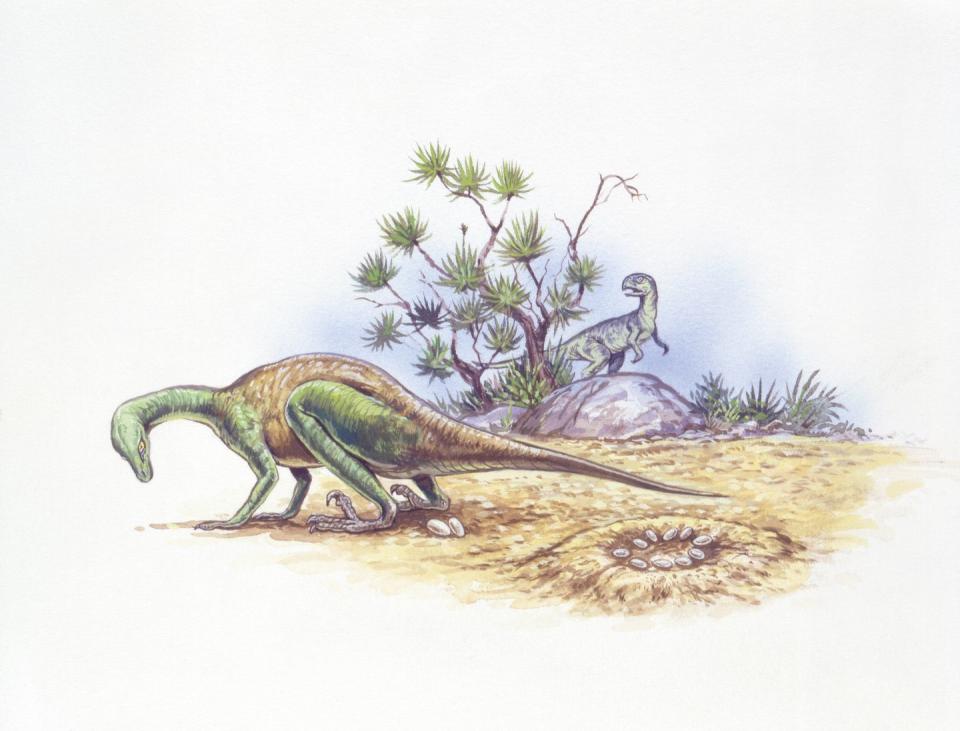Were Dinosaurs Warm-Blooded? Ancient Eggshells Point to 'Yes'

New research, published in Science Advances, proposes that dinosaurs were actually warm-blooded creatures.
A team of scientists from Yale University studied the arrangement of atoms in dinosaur eggshells to determine that the mothers who carried the eggs had warmer body temperatures than their surrounding environment.
The research may also help shed new light on why dinosaurs evolved to grow feathers.
Ancient history holds many secrets that we haven't yet discovered, and sometimes, those secrets come from fossilized dinosaur eggshells. Researchers at Yale divined this particular dino secret by studying the atom arrangement of 75-million-year-old eggshells, revealing that dinosaurs actually had warmer blood than their surrounding environment.
The researchers used a method called "clumped isotope paleothermometry" to analyze the atomic makeup of eggshells. By studying the order of the oxygen and carbon atoms in a fossilized eggshell, the scientists could determine the internal body temperature of the mothers.
This, however, doesn't definitively prove that all dinosaurs across the board were warm-blooded. In fact, that very issue has been a debate for years as scientists have tried to figure out whether the creatures ran hot or cold.
According to Pincelli Hull, a paleontologist and professor of geology and geophysics at Yale and one of the study co-authors, the eggs "act like ancient thermometers" because they developed within the bodies of their mothers.
The team studied eggs from three different groups of dinosaurs which included those closely related to birds and some more distantly related. They found that the Troodon had a varying temperature reading ranging between 100.4, 80.6, and 82.4 degrees Fahrenheit.

The fossilized eggshells of Maiasaura—a large herbivore who lived during the upper Cretaceous period—indicated that the mother's internal temperature was 111.2 degrees F while the oospecies Megaloolithus had a temperature of 96.8 degrees F.
The researchers also analyzed the fossilized shells of cold-blooded invertebrates found in the same areas as the dinosaur eggshells in order to get a reading on local temperatures and gauge whether or not the dinosaurs had higher body temps than their surroundings.
They discovered that the Troodon and Maiasaura were each 18 and 27 degrees F higher than their environments, respectively, and Megaloolithus ranged between 5.4 and 10.8 degrees F higher.
"Dinosaurs sit at an evolutionary point between birds ... and reptiles, which are cold-blooded," says Robin Dawson, lead author of the study.
"Our results suggest that all major groups of dinosaurs had warmer body temperatures than their environment," Dawson adds. So while it seems likely that dinosaurs could have been warm-blooded, more evidence is needed before we can know for sure.
Additionally, some research says that dinosaurs were neither warm- or cold-blooded but lived in the space in between, known as mesotherms. Instead of being "sluggish like lizards," or "high-energy like mammals," Nature reported back in 2014, dinosaurs may have been like modern day tuna or leatherback turtles, who existed in the "middle ground."
Still, this research could help unravel another mystery—why dinosaurs evolved to grow feathers. Dawson notes that the ability to partially thermoregulate was an "early, evolved trait for dinosaurs," and that physical traits like feathers (which were likely insulating) would later became tools to help birds fly and put on elaborate displays for potential mates.
You Might Also Like


